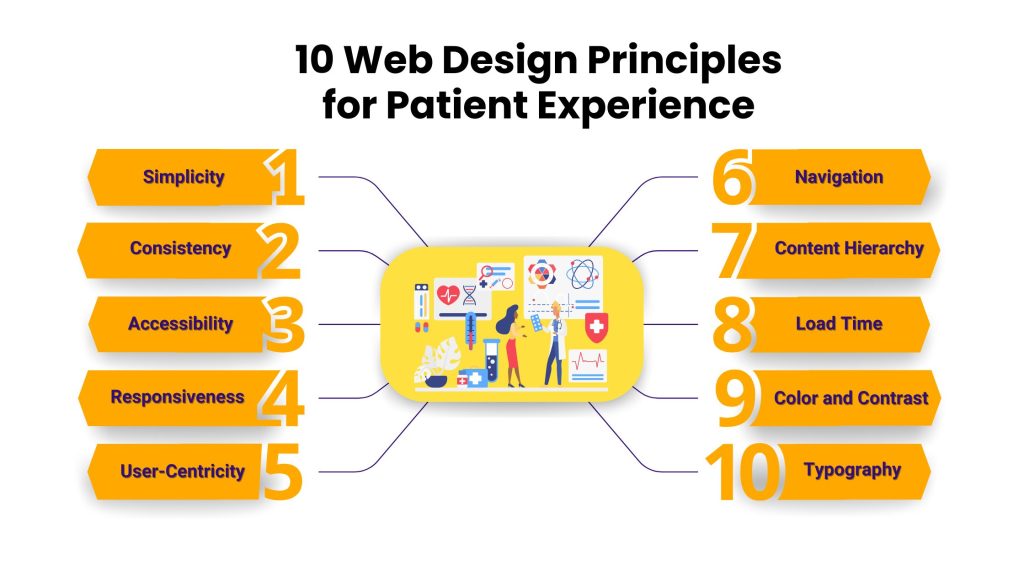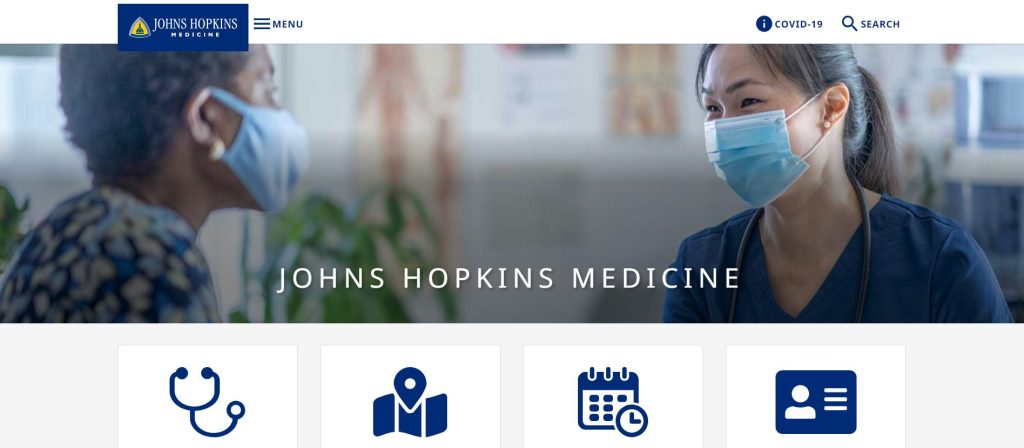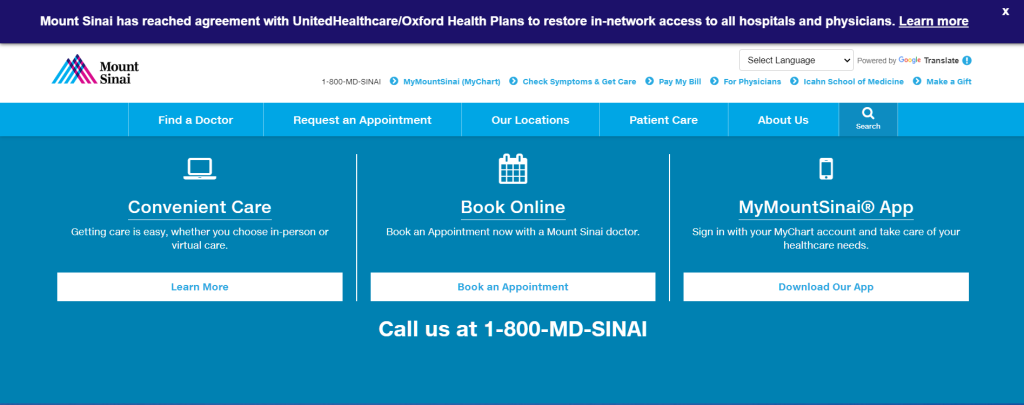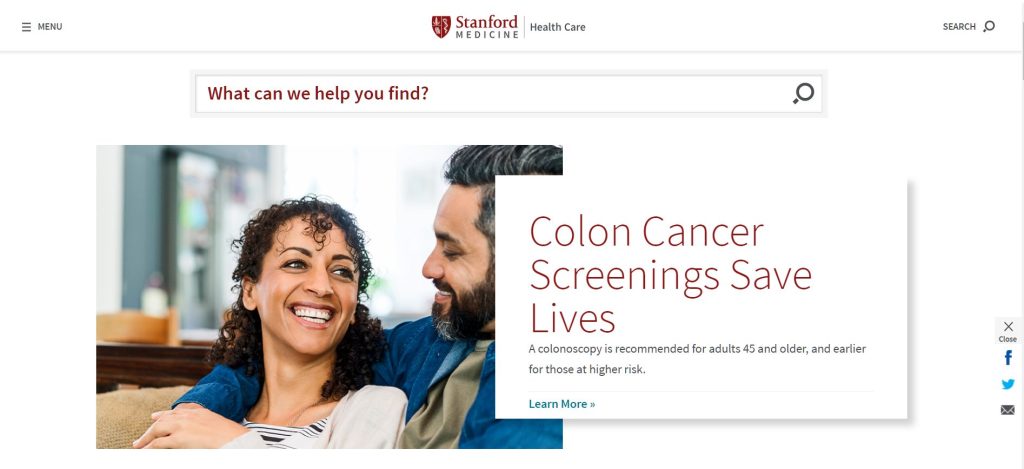
Table of Contents
ToggleEnhancing Healthcare: 10 Web Design Principles for Patient Experience
Healthcare organizations face the critical challenge of developing web platforms that deliver comprehensive services and foster a positive patient experience. Adhering to fundamental principles of website design is crucial to achieving this objective.
The essential principles of web design in healthcare focus on creating user-centric interfaces, ensuring accessibility, Search Engines Optimization (SEO), and maintaining robust security measures. Each of these components plays a vital role in enhancing patient engagement and building trust, thereby transforming the healthcare journey.
Here’s a detailed account of each of these elements.
User-Centric Interfaces: The Heart of Healthcare Website Design
At the core of effective healthcare website design is the principle of user-centricity. A user-centric interface focuses on the needs and behaviors of patients, making navigation intuitive and information easily accessible. Studies have shown that websites with clear navigation and readable content significantly improve user satisfaction and engagement. Incorporating features such as simplified menus, clear call-to-action (CTA) buttons, and a responsive design ensures that patients of all ages and tech-savviness can find the information they need without frustration.
Accessibility: Ensuring Inclusivity in Healthcare

Image Source : Accessibility Checker
Accessibility in web design is not just a legal requirement under the Americans with Disabilities Act (ADA); it’s a moral imperative, especially in the healthcare sector. An accessible website ensures all patients, including those with disabilities, have equal access to information and services. Implementing accessibility standards, such as those outlined in the Web Content Accessibility Guidelines (WCAG), enhances the usability of a website for people with visual, auditory, motor, or cognitive disabilities. For instance, providing text alternatives for non-text content and ensuring keyboard navigability can significantly affect user experience.
SEO: The Gateway to Online Visibility
Search Engine Optimization (SEO) is another crucial principle in healthcare website design. A survey conducted by Think With Google found that nearly 77% of patients conduct online research before scheduling an appointment. Therefore, a well-optimized website is more likely to appear in search results, leading to increased visibility and attracting more patients. Key SEO strategies include using relevant keywords, optimizing website speed, and creating quality content addressing patient queries. Moreover, local SEO tactics can help patients find healthcare services in their vicinity, further enhancing the website’s utility.
Security: Building Trust Through Protection
Security is paramount in healthcare website design due to the sensitive nature of medical information. A breach can severely damage a healthcare provider’s reputation and erode patient trust. Adhering to Health Insurance Portability and Accountability Act (HIPAA) guidelines for protecting patient information is essential. This includes implementing secure socket layer (SSL) encryption, regular security audits, and secure data storage solutions. Demonstrating a commitment to security can significantly impact patient confidence in using your web services.
10 Web Design and Development Principles for Patient Experience
Certain foundational principles guide the crafting of websites that stand the test of time and technology. These principles ensure that a website is not only aesthetically pleasing but also functional, accessible, and efficient. Integrating these key Website Design and Development Services is paramount for healthcare providers aiming to make a significant impact online.

Below are 10 key website design principles that should underpin every decision in the website development process:
- Simplicity: Keep design elements minimal to enhance user focus and ease of navigation for patients.
- Consistency: Ensure uniformity in fonts, colors, and layout throughout the website for coherence.
- Accessibility: Design for all, incorporating features that aid users with disabilities.
- Responsiveness: Optimize for devices, ensuring seamless viewing on phones, tablets, and PCs.
- User-Centricity: Prioritize the needs and behaviors of users in the design process.
- Navigation: Implement intuitive site navigation for easy access to information.
- Content Hierarchy: Use visual hierarchy to guide users to important information and actions.
- Load Time: Optimize images and code for fast loading, enhancing user experience.
- Color and Contrast: Use color and contrast effectively for readability and to evoke emotions.
- Typography: Choose readable and web-friendly fonts for clear communication.
These principles act as a compass in the complex process of healthcare website design, where clarity, trust, and accessibility are crucial. By adhering to these guidelines, healthcare websites can deliver exceptional experiences that resonate with users and stand out in the digital landscape.
Some Great Examples of Healthcare Website Designs
Here is a list of great healthcare website designs that excellently integrate user-centric design, accessibility, robust functionality, and aesthetic appeal. These are widely recognized for their excellence in healthcare web design.

Highlights: This site is renowned for its user-friendly interface, comprehensive health information, and easy navigation. It effectively combines valuable patient resources, including appointment booking and access to health records, with a clean and intuitive design.
2. Mayo Clinic

Highlights: This site is renowned for its user-friendly interface, comprehensive health information, and easy navigation. It effectively combines valuable patient resources, including appointment booking and access to health records, with a clean and intuitive design.

Highlights: With its patient-centric design, Johns Hopkins Medicine’s website offers easy access to medical services, health information, and researcher profiles. The site’s layout and functionality reflect its commitment to healthcare and education.
4. Mount Sinai

Highlights: Mount Sinai’s website features a modern, clean design with straightforward navigation to healthcare services, physician profiles, and patient care information. Its use of visuals and color enhances user engagement and accessibility.

Highlights: The website provides a seamless experience with its mobile-friendly design, comprehensive health library, and patient portal access. It’s designed to connect patients easily with healthcare providers and resources.
These websites exemplify how the principles of effective web design can be applied in the healthcare sector to enhance patient experience, engagement, and access to care. They serve as benchmarks for other healthcare organizations looking to improve their online presence.
Integrating Key Web Design Principles: The Great Lakes Approach
Great Lakes has pioneered integrating these key principles into healthcare website design. By focusing on user-centric interfaces, we ensure that our websites are intuitive and easy to navigate for patients and healthcare professionals alike. Our commitment to accessibility means our designs are inclusive, catering to users with various needs. Through strategic SEO practices, we enhance online visibility for healthcare providers, making it easier for patients to find the services they need. Lastly, our robust security measures build a foundation of trust with users, safeguarding their sensitive information.
Conclusion
The principles of website design are instrumental in crafting healthcare websites that offer an enhanced patient experience. By prioritizing user-centric design, accessibility, SEO, and security, healthcare providers can develop websites that not only meet the needs of their patients but also exceed their expectations. These websites serve as powerful tools in patient engagement and trust-building, ultimately contributing to better healthcare outcomes.
Are you ready to transform your healthcare website into a patient-friendly, secure, and visible online platform? Great Lakes is here to help. Our expertise in healthcare web design ensures that your website is not just a portal for information but a gateway to better patient care. Contact us today to learn how we can help you integrate these essential web design principles into your healthcare website.
Let’s work together to enhance the patient experience through superior web design.
